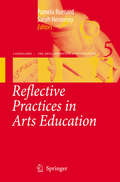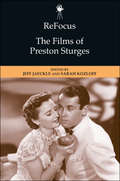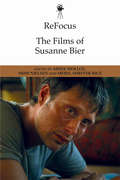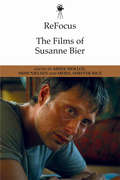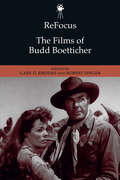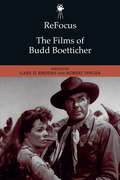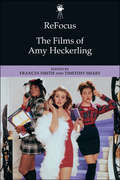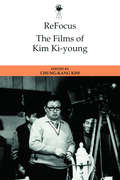- Table View
- List View
Reflections on Architecture, Society and Politics: Social and Cultural Tectonics in the 21st Century
by Graham CairnsReflections on Architecture, Society and Politics brings together a series of thirteen interview-articles by Graham Cairns in collaboration with some of the most prominent polemic thinkers and critical practitioners from the fields of architecture and the social sciences, including Noam Chomsky, Peggy Deamer, Robert A.M. Stern, Daniel Libeskind and Kenneth Frampton. Each chapter explores the relationship between architecture and socio-political issues through discussion of architectural theories and projects, citing specific issues and themes that have led to, and will shape, the various aspects of the current and future built environment. Ranging from Chomsky’s examination of the US–Mexico border as the architecture of oppression to Robert A.M. Stern’s defence of projects for the Disney corporation and George W. Bush, this book places politics at the center of issues within contemporary architecture.
Reflections on Baroque
by Robert HarbisonFrom its beginnings in the seventeenth century, the eccentric and tumultuous forms of the Baroque spread across not only Europe but colonial Latin America and Asia as well. With Reflections on Baroque, Robert Harbison brings together discussions of aesthetics, science, mysticism, politics, religion, and culture to offer a surprising reinterpretations of the baroque style and its influences and echoes into the twentieth century.
Reflections on Critical Museology: Inside and Outside Museums (Museums in Focus)
by J. Pedro LorenteReflections on Critical Museology: Inside and Outside Museums offers a reflective and reflexive re-assessment of museum studies and the first wide-ranging account of critical museology. Drawing on an extensive range of examples from museums and across the museological literature, which are purposefully representative of very different cultural backgrounds, the book issues a plea for critical thinking in and about museums. The various institutions covered and the plural analytical standpoints offer a broad interdisciplinary approach by intermingling art history, anthropology, sociocultural theories and heritage studies. The result is not claimed as a universal or all-encompassing account but a subjective review produced by J. Pedro Lorente, an art critic and historian who has been writing extensively about ‘critical museology’ in different languages for many years. Lorente offers a fascinating synopsis of his ideas in this extremely valuable short book, looking inside and outside museums, combining practice and theory, whilst also relating both to the work of museum professionals and to a range of publications by academics, including those from other research fields. Reflections on Critical Museology: Inside and Outside Museums will be essential reading for university students and academics working in museum studies and cognate disciplines, such as art history, anthropology and cultural studies.
Reflections on Critical Museology: Inside and Outside Museums (Museums in Focus)
by J. Pedro LorenteReflections on Critical Museology: Inside and Outside Museums offers a reflective and reflexive re-assessment of museum studies and the first wide-ranging account of critical museology. Drawing on an extensive range of examples from museums and across the museological literature, which are purposefully representative of very different cultural backgrounds, the book issues a plea for critical thinking in and about museums. The various institutions covered and the plural analytical standpoints offer a broad interdisciplinary approach by intermingling art history, anthropology, sociocultural theories and heritage studies. The result is not claimed as a universal or all-encompassing account but a subjective review produced by J. Pedro Lorente, an art critic and historian who has been writing extensively about ‘critical museology’ in different languages for many years. Lorente offers a fascinating synopsis of his ideas in this extremely valuable short book, looking inside and outside museums, combining practice and theory, whilst also relating both to the work of museum professionals and to a range of publications by academics, including those from other research fields. Reflections on Critical Museology: Inside and Outside Museums will be essential reading for university students and academics working in museum studies and cognate disciplines, such as art history, anthropology and cultural studies.
Reflections on the Aesthetic Experience: Psychoanalysis and the uncanny (The New Library of Psychoanalysis 'Beyond the Couch' Series)
by Gregorio KohonInterest in the relationship between psychoanalysis and art - and other disciplines - is growing. In his new book Reflections on the Aesthetic: Psychoanalysis and the uncanny, Gregorio Kohon examines and reflects upon psychoanalytic understandings of estrangement, the Freudian notions of the uncanny and Nachträglichkeit, exploring how these are evoked in works of literature and art, and are present in our response to such works. Kohon provides close readings of and insights into the works of Franz Kafka, Jorge Luis Borges, Louise Bourgeois, Juan Muñoz, Anish Kapoor, Richard Serra, Edvard Munch, Kurt Schwitters, amongst others; the book also includes a chapter on the Warsaw Ghetto Monument and the counter-monument aesthetic movement in post-war Germany. Kohon shows how some works of art and literature represent something that otherwise eludes representation, and how psychoanalysis and the aesthetic share the task of making a representation of the unrepresentable. Reflections on the Aesthetic is not an exercise in "applied" psychoanalysis; psychoanalysis and art are considered by the author in their own terms, allowing a new understanding of the aesthetic to emerge. Kohon’s book makes compelling reading for psychoanalysts, psychotherapists, art therapists, literary and art critics, academics, students and all those interested in the matter of the aesthetic.
Reflections on the Aesthetic Experience: Psychoanalysis and the uncanny (The New Library of Psychoanalysis 'Beyond the Couch' Series)
by Gregorio KohonInterest in the relationship between psychoanalysis and art - and other disciplines - is growing. In his new book Reflections on the Aesthetic: Psychoanalysis and the uncanny, Gregorio Kohon examines and reflects upon psychoanalytic understandings of estrangement, the Freudian notions of the uncanny and Nachträglichkeit, exploring how these are evoked in works of literature and art, and are present in our response to such works. Kohon provides close readings of and insights into the works of Franz Kafka, Jorge Luis Borges, Louise Bourgeois, Juan Muñoz, Anish Kapoor, Richard Serra, Edvard Munch, Kurt Schwitters, amongst others; the book also includes a chapter on the Warsaw Ghetto Monument and the counter-monument aesthetic movement in post-war Germany. Kohon shows how some works of art and literature represent something that otherwise eludes representation, and how psychoanalysis and the aesthetic share the task of making a representation of the unrepresentable. Reflections on the Aesthetic is not an exercise in "applied" psychoanalysis; psychoanalysis and art are considered by the author in their own terms, allowing a new understanding of the aesthetic to emerge. Kohon’s book makes compelling reading for psychoanalysts, psychotherapists, art therapists, literary and art critics, academics, students and all those interested in the matter of the aesthetic.
Reflective Affective Dramaturgies of Participatory Theatre: Larping Audiences into Performance
by Sarah HooverAs the popularity and diversity of participatory theatre productions increase, scholarly and artistic attention toward the audience as agentive contributors and interpreters must keep pace. Simultaneously, the COVID-19 pandemic has added urgency to the collective artistic encounter and its value to individual and community health. This book proposes “reflective affective” dramaturgies of participatory theatre aimed toward incorporating participants’ reflections and affective responses as material in an emergent exploration of represented systems of power. The volume's interdisciplinary theoretical frameworks stem from performance studies discourses including feminist materialism, phenomenology and affect theory, bringing them together with larp scholarship on character/self performance, agency and emergence. Through its integration of the practical and theoretical, this work serves as an essential study for scholars, students and artists in theatre studies, performance studies, visual art studies, role-play studies, cultural studies, and philosophy.
The Reflective Museum Practitioner: Expanding Practice in Science Museums
by Laura W. Martin Lynn Uyen Tran Doris B. AshThe Reflective Museum Practitioner explores a range of expansive and creative ways in which the concept of “reflective practice” has been applied in the informal STEM (science, technology, engineering, and mathematics) learning environments of museums and zoos. It seeks to demonstrate how such a process can inspire lifelong learning in practitioners, to the benefit of practitioners and visitors alike. Presenting six projects that employed reflective practice, the contributors examine how each project has encouraged and sustained reflection, and the outcomes thereof. The projects cover a wide range of different practitioners—including administrators, scientists, educators, and other front-line and back-room staff—who work at different junctures of their organizations. Collectively, they raise key questions about changing communities of practice in Informal Science Learning institutions. The projects and concept of “reflective practice” are fully defined and contextualized by the editors, who offer in-depth analysis, along with a cultural-historical activity theory framework, for understanding how changes in museum practice unfold in an institutional context. The Reflective Museum Practitioner offers museum professionals insight into “reflective practice,” as practiced by other institutions in their sector, providing practical examples that can be adapted to their needs. It will also be of interest to scholars and students focusing on science museums, or professional practice development in museums.
The Reflective Museum Practitioner: Expanding Practice in Science Museums
by Laura W. Martin Lynn Uyen Tran Doris B. AshThe Reflective Museum Practitioner explores a range of expansive and creative ways in which the concept of “reflective practice” has been applied in the informal STEM (science, technology, engineering, and mathematics) learning environments of museums and zoos. It seeks to demonstrate how such a process can inspire lifelong learning in practitioners, to the benefit of practitioners and visitors alike. Presenting six projects that employed reflective practice, the contributors examine how each project has encouraged and sustained reflection, and the outcomes thereof. The projects cover a wide range of different practitioners—including administrators, scientists, educators, and other front-line and back-room staff—who work at different junctures of their organizations. Collectively, they raise key questions about changing communities of practice in Informal Science Learning institutions. The projects and concept of “reflective practice” are fully defined and contextualized by the editors, who offer in-depth analysis, along with a cultural-historical activity theory framework, for understanding how changes in museum practice unfold in an institutional context. The Reflective Museum Practitioner offers museum professionals insight into “reflective practice,” as practiced by other institutions in their sector, providing practical examples that can be adapted to their needs. It will also be of interest to scholars and students focusing on science museums, or professional practice development in museums.
Reflective Planning Practice: Theory, Cases, and Methods
by Richard WillsonReflective Planning Practice: Theory, Cases, and Methods uses structured, first-person reflection to reveal the artistry of planning practice. The value of professional reflection is widely recognized, but there is a difference between acknowledging it and doing it. This book takes up that challenge, providing planners’ reflections on past practice as well as prompts for reflecting in the midst of planning episodes. It explains a reflection framework and employs it in seven case studies written by planning educators who also practice. The cases reveal practical judgments made during the planning episode and takeaways for practice, as the planners used logic and emotion, and applied convention and invention. The practical judgments are explained from the perspective of the authors’ personal experiences, purposes, and professional style, and their interpretation of the rich context that underpins the cases including theories, sociopolitical aspects, workplace setting, and roles. The book seeks to awaken students and practitioners to the opportunities of a pragmatic, reflective approach to planning practice.
Reflective Planning Practice: Theory, Cases, and Methods
by Richard WillsonReflective Planning Practice: Theory, Cases, and Methods uses structured, first-person reflection to reveal the artistry of planning practice. The value of professional reflection is widely recognized, but there is a difference between acknowledging it and doing it. This book takes up that challenge, providing planners’ reflections on past practice as well as prompts for reflecting in the midst of planning episodes. It explains a reflection framework and employs it in seven case studies written by planning educators who also practice. The cases reveal practical judgments made during the planning episode and takeaways for practice, as the planners used logic and emotion, and applied convention and invention. The practical judgments are explained from the perspective of the authors’ personal experiences, purposes, and professional style, and their interpretation of the rich context that underpins the cases including theories, sociopolitical aspects, workplace setting, and roles. The book seeks to awaken students and practitioners to the opportunities of a pragmatic, reflective approach to planning practice.
Reflective Practices in Arts Education (Landscapes: the Arts, Aesthetics, and Education #5)
by Pamela Burnard Sarah HennessyThis book explores reflective practice as a source and resource for teaching, learning and research in Art and Design, Dance, Drama and Music. Many of the authors are both arts educators and researchers who reflect current trends in arts education, and consider the relationships between teachers, artists and learners across disciplines. The book offers a resource for individual and collective professional development which, by its nature, involves reflecting on practice.
Reflexionen des stereoskopischen Spielfilms: Eine bildhistorische Analyse (Film)
by Luisa FeiersingerDer stereoskopische Unterhaltungsfilm, der sogenannte 3D-Film, ist integraler Bestandteil der Filmgeschichte. Luisa Feiersinger verfolgt in einer longue durée die sich wandelnden narrativen, technischen und diskursiven Anordnungen am Beispiel ausgewählter Unterhaltungsfilme. Dabei zeigt sie, dass gerade im populären Format diese Anordnungen immer wieder selbstreflexiv in die Narrationen verwoben werden. Filmwissenschaftliche Untersuchungsmethoden zur Beschreibung der nur in der Wahrnehmung existierenden stereoskopischen Bewegt- und Raumbilder dienen als exemplarischer Vorschlag zur Integration von Bewegtbildern in die Kunst- und Bildgeschichte.
Reflexive Kataloge: Ein Medium der Übersetzung als Ausstellung, Film und Hypertext (Image #190)
by Ulrike FelsingFür gewöhnlich präsentieren Ausstellungskataloge das Kunstwerk als von Zeit und Raum losgelöste Reproduktion. Die visuelle Reflexion und die mediale Übersetzung gewinnen jedoch zunehmend an Bedeutung: Neue Bedürfnisse in der Dokumentation von Installations- und Konzeptkunst, die rasante Verbreitung des Internets sowie der damit verbundene Innovationsdruck auf das klassische Buch lassen auch neue Katalogformen entstehen. Ulrike Felsing stellt diese Reflexiven Kataloge vor, die raumbezogene, film- und hypertextartige Präsentationsformen nutzen, um relevante Zusammenhänge zu vermitteln.
The Reflexive Teaching Artist: Collected Wisdom from the Drama/Theatre Field (PDF) (Theatre In Education Ser.)
by Daniel A. Kelin Kathryn DawsonWriting from the dual perspectives of artist and educator, Kathryn Dawson and Daniel A. Kelin II raise fundamental questions about the complex functions of the teaching artist in school, community and professional theatre settings. Contributions to the text explore a series of foundational concepts, including intentionality, quality, artistic perspective, assessment and praxis, all used as a reflective framework to illuminate case studies from a wide range of teaching artist practice. Readers are also offered questions to guide their practical application, charts to complete, and the editors examine the practice of teaching in, through and about drama and theatre.
ReFocus: The Films of Preston Sturges (ReFocus)
by Jeff Jaeckle Sarah KozloffDirector, screenwriter and comic genius, Preston Sturges has been an influence on filmmakers ranging from Orson Welles to the Coen brothers. The first person to win an Oscar for Best Original Screenplay, he wrote and directed some of the most bizarre, controversial, and downright hilarious comedies of the 1940s, including Sullivan’s Travels and Hail the Conquering Hero. He may be the most talented Hollywood filmmaker yet to receive the critical recognition he deserves. The Films of Preston Sturges is a pioneering collection of essays by world-famous scholars that chart Sturges’ contributions to Hollywood cinema, revealing his pivotal status as an early writer-director, exploring his inimitable style, and making a bold case for his ongoing influence today. Reawakening interest in this filmmaker’s life and works, this book will remind readers why Sturges’ movies remain not only immensely enjoyable, but of great cultural significance as well.
ReFocus: The Films of Susanne Bier
by Missy Molloy Mimi NielsenA new critical and theoretical approach to a neglected aspect of Pedro Almodóvar’s cinema
ReFocus: The Films of Susanne Bier (Refocus: The International Directors Ser.)
by Missy Molloy Mimi NielsenA comprehensive study of Raymond Bellour, one of the most important foundational theorists of Film Studies
ReFocus: The Films of Budd Boetticher (ReFocus)
by Gary D Rhodes Robert SingerOne of the most important yet overlooked of Hollywood auteurs, Budd Boetticher was responsible for a number of classic films, including his famous ‘Ranown’ series of westerns starring Randolph Scott. With influential figures like Martin Scorsese and Clint Eastwood acknowledging Boetticher’s influence, and with growing academic interest in his work, Gary D. Rhodes and Robert Singer present a vital collection of essays on the director’s long career, from a range of international scholars. Looking at celebrated films like Buchanan Rides Alone (1958) and Comanche Station (1960), as well as at lesser-known works like Escape in the Fog (1945) and Behind Locked Doors (1948), this book also addresses Boetticher’s influential television work on the James Garner series Maverick, and Boetticher’s continuing aesthetic influence on contemporary TV classics like Breaking Bad.
ReFocus: The Films of Budd Boetticher (ReFocus)
by Gary D Rhodes Robert SingerOne of the most important yet overlooked of Hollywood auteurs, Budd Boetticher was responsible for a number of classic films, including his famous ‘Ranown’ series of westerns starring Randolph Scott. With influential figures like Martin Scorsese and Clint Eastwood acknowledging Boetticher’s influence, and with growing academic interest in his work, Gary D. Rhodes and Robert Singer present a vital collection of essays on the director’s long career, from a range of international scholars. Looking at celebrated films like Buchanan Rides Alone (1958) and Comanche Station (1960), as well as at lesser-known works like Escape in the Fog (1945) and Behind Locked Doors (1948), this book also addresses Boetticher’s influential television work on the James Garner series Maverick, and Boetticher’s continuing aesthetic influence on contemporary TV classics like Breaking Bad.
ReFocus: The Films of Amy Heckerling (ReFocus)
by Frances Smith Timothy SharyRefocus: The Films of Amy Heckerling is the first book-length study of the work of Amy Heckerling, the phenomenally popular director and screenwriter of Clueless and Fast Times at Ridgemont High. As such, the book constitutes a significant intervention in Film Studies, prompting a reconsideration of the importance of Heckerling both in the development of Teen cinema, and as a figure in Hollywood comedy. As part of the Refocus series, the volume brings together outstanding original essays examining Heckerling’s work from a variety of perspectives, including film, television and cultural studies and is destined to be used widely in undergraduate teaching.
ReFocus: The Films of Kim Ki-young (ReFocus: The International Directors Series)
by Edited by Chung-kang KimWorld-renowned South Korean directors, including Park Chan-wook and Bong Joon Ho, cite Kim Ki-young as being the greatest Korean influence on their work. During his thirty year career, Kim Ki-young produced thirty-three films and became revered by critics within the national and international community as one of the few South Korean ‘auteurs’. As the first comprehensive scholarly volume on Kim Ki-young in English, ReFocus: The Films of Kim Ki-young covers his entire career and history of cinematic work, highlighting the thematic and stylistic singularity of Kim’s oeuvre, which was produced relative to the specific historical and cultural conditions of post-war South Korea. It offers an innovative departure point from which to explore South Korean film relative to the wider history of world cinema, in addition to situating Kim’s work within the broader fields of Korean modern history, transnational cinema and cultural studies.
ReFocus: The Films of Kim Ki-young (ReFocus: The International Directors Series)
by Chung-Kang KimWorld-renowned South Korean directors, including Park Chan-wook and Bong Joon Ho, cite Kim Ki-young as being the greatest Korean influence on their work. During his thirty year career, Kim Ki-young produced thirty-three films and became revered by critics within the national and international community as one of the few South Korean ‘auteurs’. As the first comprehensive scholarly volume on Kim Ki-young in English, ReFocus: The Films of Kim Ki-young covers his entire career and history of cinematic work, highlighting the thematic and stylistic singularity of Kim’s oeuvre, which was produced relative to the specific historical and cultural conditions of post-war South Korea. It offers an innovative departure point from which to explore South Korean film relative to the wider history of world cinema, in addition to situating Kim’s work within the broader fields of Korean modern history, transnational cinema and cultural studies.
Reformations of the Body: Idolatry, Sacrifice, and Early Modern Theater (Early Modern Cultural Studies 1500–1700)
by J. WaldronThis project takes the human body and the bodily senses as joints that articulate new kinds of connections between church and theatre and overturns a longstanding notion about theatrical phenomenology in this period.
Reformed Theology And Visual Culture: The Protestant Imagination From Calvin To Edwards (PDF)
by William A. DyrnessWith the walls of their churches bereft of imagery and colour and their worship centered around sermons with carefully constructed outlines (as opposed to movement and drama), Reformed Protestants have often been accused of being dour and unimaginative. Here, William Dyrness explores the roots of Reformed theology in an attempt to counteract these prevailing notions. Studying sixteenth-century Geneva and England, seventeenth-century England and Holland and seventeenth and eighteenth-century Puritan New England, Dyrness argues that, though this tradition impeded development of particular visual forms, it encouraged others, especially in areas of popular culture and the ordering of family and community. Exploring the theology of John Calvin, William Ames, John Cotton and Jonathan Edwards, Dyrness shows how this tradition created a new aesthetic of simplicity, inwardness and order to express underlying theological commitments. With over forty illustrations, this book will prove invaluable to those interested in the Reformed tradition.







